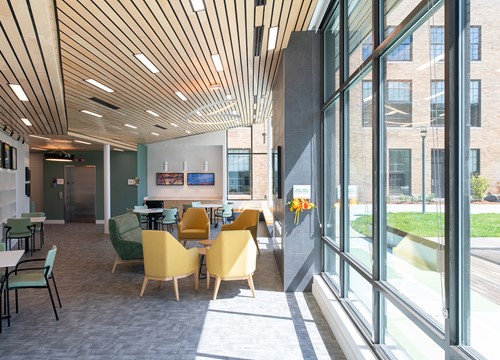This is the third of three blog posts in which University of North Carolina-Chapel Hill Professor James H. Johnson, Jr., PhD, lays out the current landscape facing CCRCs, from placement challenges for older adults to strained workforce issues to strategies for the future.
In my previous two posts, I addressed incoming resident and workforce issues and challenges CCRCs confronted during the COVID crisis, which remain operational challenges today. This post outlines strategies for resolving these challenges which, if left unaddressed, will threaten the future viability and sustainability of the CCRC model of senior care. All three posts are drawn from findings from a study commissioned by a statewide association representing CCRCs in the Southern United States.
First, given expressed concerns about the health and well-being of new members entering CCRCs through independent living, CCRC leaders must re-think in-take procedures for new members. One CCRC manager offered the following advice regarding how CCRCs can do a better job of screening and evaluating the health status of incoming new community members:
“I know there’s an interview process right before they move in, and I think that … needs to be revaluated. I think there should be a healthcare worker in [the interviews], not just office staff. It has to be somebody [with] a medical background that [can] do a medical assessment. Medical personnel need to be in the meeting right before a resident moves in because it’s getting to the point where it’s not safe for the residents and it’s not safe for the workers, either.”
Second, CCRCs must do a better job of addressing, head-on, challenges and obstacles their workers, especially those in frontline jobs, face in their personal lives that make it difficult for them to perform their duties. Notably, immigrants and people of color make up a significant share of the CCRC frontline workforce.
The frontline workers we interviewed did not hesitant to share the obstacles they confront outside of work.
‘It’s the mental state of constantly trying to figure out your life and livelihood before the next day comes.’
One CNA shared the following narrative:
“I’m a single wage earner now because my children’s father was deported from this country. So, it’s just me. I have no other income coming from anywhere and this is my only job. Because I am back in school and I have kids, it gets tough … it gets difficult. I work all the time because I have to be able to afford where I am living … where I’m taking my kids. I was in [a] neighborhood where my car got shot up. I had 31 [bullet] holes in my car. I had to move out of there and move to a decent place where I can leave my kids home and come to work and [not] have to worry about [bullets] flying through the window. To afford to live in [that type of place], I have to work overtime.”
Describing her situation, a home health worker, who must maintain 30 hours of work weekly to receive health insurance from her CCRC employer, said:
“It’s the mental state of constantly trying to figure out your life and livelihood before the next day comes. This is the situation we’re in and it’s very sad. You are here to take care of your members, and everyone is aging. Everyone needs help and sometimes you know with this member, she’s getting to that point, and you don’t want to lose her, but your mind is at home … thinking that I still need my hours. I still need a paycheck. So, I am struggling to balance it out.”
Commenting on the escalating cost of living and encountering difficulty making ends meet financially, a CCRC maintenance worker said:
“It’s gotten worse [since COVID] because the cost of living—food, lights—everything has gone up. Pre-COVID was better. It was much more manageable for me. Rent was at a decent level. Lights were fine. Groceries were fine. I was able to see a little bit of funds left in my account. Now you feel like you got to budget.”
Echoing a similar sentiment, another CCRC home healthcare worker stated:
“The cost of living is just going up … everything is up except our pay … when prices go up, it’s hard to get meat or you’re living off bread and peanut butter.”
‘The cost of living is just going up … everything is up except our pay.’
A CCRC maintenance worker, reflecting on his lived experiences, recounted:
“I’ve been at the same apartment for 3 years now. And each year the rent goes up $50-$75 a month and it’s getting harder to pay for it, especially when your pay doesn’t go up. And then you have to think about food, gas, and everything else.”
Speaking more broadly about worker challenges, a CCRC frontline worker reported:
“I know several people who have to have several jobs just to keep up and they don’t want to leave [unnamed CCRC]. I mean it is a great place to work, but when it comes down to just the financials of it, if it was just the financial aspect, I don’t think anyone would be here.”
These and other worker challenges require CCRCs to pursue a two-pronged workforce recruitment and retention strategy.
- Push back on recent White House Executive Orders on immigration and DEI (diversity, equity, and inclusion). In so doing, CCRCs must make the case, as we have done elsewhere, that embracing immigrants and leveraging evidenced-based diversity best practices are necessary if CCRCs are going to win the war for talent in a society that is aging rapidly and becoming increasingly diverse as people of color drive growth.
- Replicate a strategy the Census Bureau initiated during the COVID-19 crisis. That is, as a tactic to demonstrate more empathy and compassion for their employees, CCRCs should conduct pulse surveys on a routine basis to identify and monitor the types of challenges and obstacles workers are facing in their personal lives. And based the survey results, CCRCs should devise workforce and workplace accommodations that make it possible for workers to continue to do their jobs.
From existing research, we know that pursuing these strategies and specifically making prudent investments in affordable workforce housing and accessible, affordable, and high-quality childcare not only reduce labor turnover but also create a strong sense of inclusion and belonging for workers who benefit from such accommodations.
James H. Johnson, Jr., PhD, is a William Rand Kenan, Jr. Distinguished Professor in UNC-Chapel Hill’s Kenan-Flagler Business School.
Photo caption: Exterior view of an assisted living facility in Rochester, Mich.
Photo credit: Shutterstock/Fsendek













